Persian carpets have a very long history in the tradition of Iran and its surrounding countries. They were once made for personal use or for trade. Their production by hand is a difficult and it requires skill, practice and a good eye to evenly knot the complex patterns. A Persian carpet is a great design element that fits both into traditional rooms as well as modern rooms. In this post, we are sharing you recommendations for the best Persian rugs and give you some tips how to tell if a Persian rug is real or fake.
Paragraph: How to tell if a Persian rug is authentic
An authentic Persian rug is a handmade product with a much higher quality than any machine-produced product. That also means that the price of a real Persian carpet is generally considerably higher than the price of other products. Therefore, it is very important to be sure to get an authentic product when considering the purchase of a Persian carpet. To help you with your peace of mind, we will show you what defines a real Persian rug and how to tell if a Persian rug is authentic.
What defines a real Persian carpet?
A Persian carpet is characterized by the facts that it is handmade, made in Persia (Iran) and made with natural fibers such as cotton, sheep wool or silk. This type of carpet is often called Oriental carpet, as it originated in the region. The tradition and the art of making Persian carpets dates back for thousands of years. The production of a Persian carpet takes on average around 2-3 months, while a machine-woven rug is usually produced within 2-3 hours. But there are several ways of telling if a Persian carpet is authentic or not.
If you check the 5 points listed below before buying a Persian rug, you can independently determine whether the carpet is original or not.
Check the Symmetry
In general, no handmade Persian rug is completely symmetrical. For one thing, the shape will always be a little odd. On the other hand, the design of one half of the carpet cannot be exactly mirrored. A weaver sits at a carpet for months and cannot repeat small details or ornaments 1:1 from his head. But that is exactly what a machine does. It creates perfectly symmetrical designs and shapes. The fact that all authentic Persian and Oriental rugs unique pieces makes them so special.
Identification tip: Deviations from the symmetry or blemishes are signs of a hand-knotted authentic carpet.
Check the Fringes
In short, a genuine Oriental or Persian carpet has no sewn-on fringes. The fringes form the end of the chain yarns and are therefore an integral part of the carpet. If you check the back of the carpet and see that the fringes have been sewn on, then it is most likely not a genuine oriental carpet.
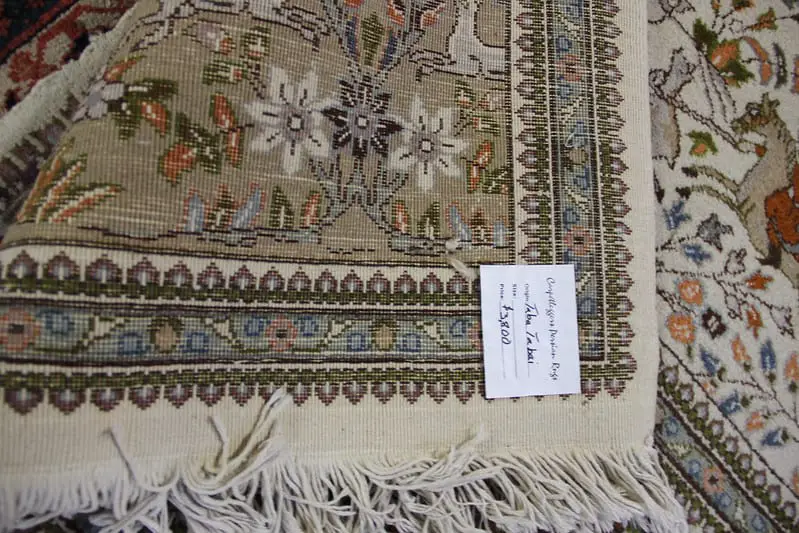
Identification tip: A real oriental or Persian carpet does not have sewn-on fringes
Check the regularity of the knots
On the back of a carpet you can see the individual knots, provided the carpet has been knotted and not woven. The knots give experts a deep insight into the knotting method, fineness, effort and quality of a carpet. As mentioned before, hand-knotted carpets are never completely flawless. You can see that especially well in the knots. Irregularities and minor faults are absolutely normal on the back of an Oriental carpet.
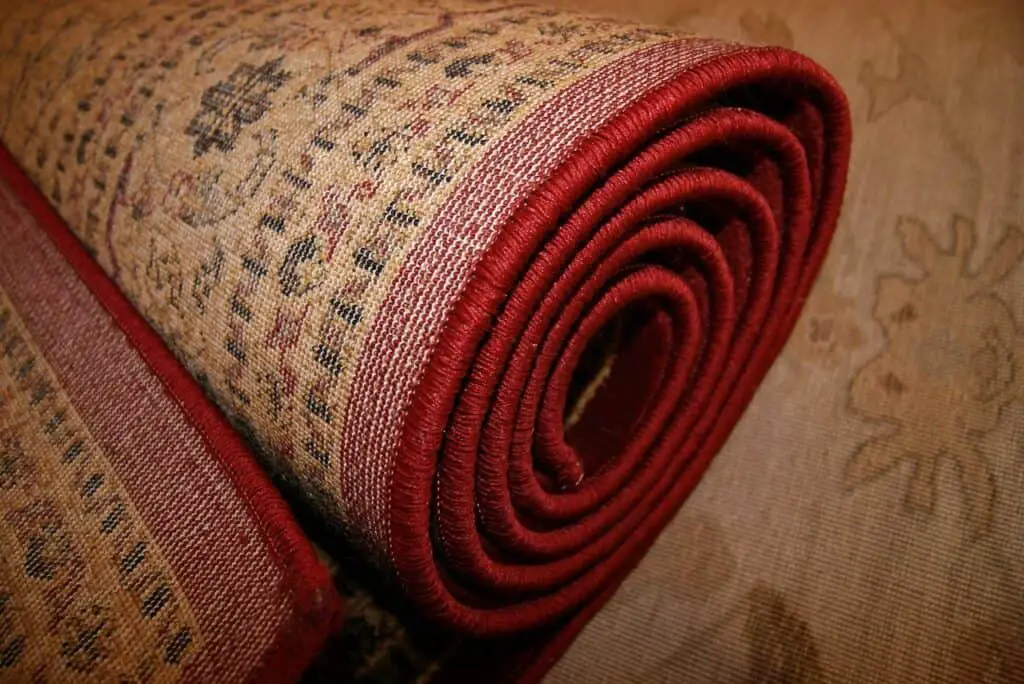
Identification tip: If each row of knots on the back is regular and free of faults, you are looking at a machine-made carpet.
What material is the Persian rug made of?
Traditional Oriental rugs consist purely of natural materials. These can be sheep wool, cotton, camel hair or pure silk. For the surface (the pile) sheep wool is usually used, while the back (the warp) is often made of cotton or also sheep wool. Very high quality carpets are completely made of natural silk. Machine-made carpets can also be made of wool, but often they are at least partly made of synthetic fibers. These carpets usually use cheap materials on the back to reduce the production cost.
Identification tip: If the carpet has a synthetic backside, it is an industrially-produced carpet.
Look at the knot density
The knot density determines the quality of a carpet. You can think of the knot density in much the same way as the resolution of a screen. The more knots a rug has, the more detail and the more beautiful the finish. However, this also requires much more effort, skill and time in knotting. Therefore, you can check the knot density to identify particularly high-quality Persian carpets.
Identification tip: A high knot density is an indicator for a high-quality carpet.
Check the pile height
In addition to the knot density, the pile height, i.e. the thickness of the carpet, is an indicator of its value. The thinner a hand-knotted carpet is, the higher its value is. Only very skilled knotters can make a very thin and even carpet.
Identification tip: Very valuable Persian carpets are usually only 3-6mm thick.
Buy from a reputable seller
This is actually one of the most important factors to get an authentic Persian carpet. Only buy Persian rugs from trusted sellers. We at PersianExperts.com recommend RugSource.com as the number one carpet dealer that deals in high-value authentic Persian rugs.
Formats of Persian rugs
Persian carpet sizes are usually not determined by the weaver but are dictated by tradition. The traditional formats of Persian rugs are:
- Ghali: 190×280cm
- Dozar (or Sedjadeh): 130–140cm (51–55in) x 200–210cm (79–83in)
- Ghalitcheh 130–140cm (51–55in) x 200–210cm (79–83in)
- Kelleghi or Kelley: 150–200 cm (59–79 in) x 300–600 cm (120–240 in)
- Kenareh: 80–120 cm (31–47 in) × 250–600 cm (98–236 in)
- Zaronim: 100x150cm (39-59 in)
Most popular Persian carpet designs
One of the main features of a Persian carpet are certain repetitive ornaments, motifs and patterns. The traditional designs have remained unchanged over centuries. A Persian carpet has a large central field. The design of the elements in the center is either geometrical or floral. Around the center is a wide main border. The design of the main border is usually floral, or contains arabesques, or both.
The designs and patterns themselves depend on the area in Persia where the carpet is produced. Therefore, for example, a “Shiraz” Persian carpet is from the Shiraz region and bears certain design elements that are typical for that area.
Independent of the design, the most important thing is the symmetry. The two halves of the main field are always identical in design. Since the rug is the most important element of a traditional room, the pattern should be visible from every direction
Original and Handmade – The best Persian rugs – Our Staff’s Recommendations
We have asked our staff to pick out their favorite Persian rugs that are currently available. All these rugs are 100% authentic Persian rugs and therefore unique pieces. Our trusted partner RugSource.com offers a 30-day return guarantee and same-day shipping. A real Persian rug lasta a lifetime and much longer and is a real eyecatcher in every living room. If you are not yet ready to enter the financial committment of a real Persian rug, we’ve compiled a great list of affordable machine-made rugs below (or just click here to jump to that section).
Tribal Geometric Shiraz Persian Area Rug 7×9
This handmade Shiraz-style Persian rug shows some of the most characteristic features of a Persian rug. I comes in a bright red color with some ivory, golden and burgundy elements. The pattern is a beautifully woven geometric tribal design from the Shiraz area. It is hand-woven with 150 knots per square inch and consists of 100% sheep wool. The carpet comes in the Ghali size 9′ 4” X 7′ 0” (284x213cm) and is in great condition at an age of 40-50 years.
Antique Animal Pictorial Tabriz Persian Area Rug 10×13
This large 10×13 feet (3909x290cm) Persian rug immediately caught the attention of one of our female staff members. It has a beautiful floral/pictoral pattern with flowers and birds. The dominating colors are beige, orange and ivory. It is hand-woven with 120 knots per square inch and the pile consists of 100% wool while the foundation is made of cotton. This Persian carpet brings some great life and colors into every large room.
Tribal Geometric Mahal Persian Area Rug 7×9
This is a great Persian area rug for all those looking for a great combination of traditional and modern. The carpet comes in beautiful red, beige and brown colors with a beautiful and modern geometric tribal pattern from the Mahal region in Iran. Both foundation as well as pile of this high-quality rug consist of 100% wool. It is sized roughly 9×7 feet. This is a great carpet to add some color to a modern room with beige and brown furniture.
Affordable Persian style rug alternatives
As mentioned above, hand-knotted Persian carpets can be quite pricey. While they will last a lifetime, they might just be too expensive for some. Therefore, we created an overview of some great machine-made Persian style rugs in the range of around $50-100. These Persian look-alike rugs are at least partially made of synthetic materials. Nevertheless, these great cheap Persian rugs are a great way to decorate your house in style while on a budget.
Safavieh Oriental Red and Multi Area Rug – Geometric Patterns
This red oriental rug from Safavieh displays some great geometric patterns. The mix of red and blue colors makes this affordable Persian style rug ideal for any living room or other area that should feel a little more comfortable and cozy. The classic and timeless style of the rug goes with almost any decór style in your room. The rug is available in a wide range of sizes as well as in other colors.
Nourison Passion Grey/Multi Traditional Persian, Vintage Area Rug
This beautiful and cheap Persian rug comes with calming light red and creme colors. It has a floral pattern and is ideal as a subtle classic statement in a modern decorated room. It is also available in a wide range of colors.
Home Dynamix Premium Sakarya Traditional Rectangle Area Rug
This floral Persian carpet is an eye-catcher in every living room or bedroom. It has some strong black and red colors and fits ideally into a classic-decorated room with strong colors. In our opinion, the colors would be too strong in a mostly white/cream colored room. If you have the right room, this is definitely one of the greater affordable Persian rugs out there.
We hope you liked our overview of the best Persian carpets. While you are here, why not check out our other posts on great Persian products such as the best Persian saffron and the best Persian tea?

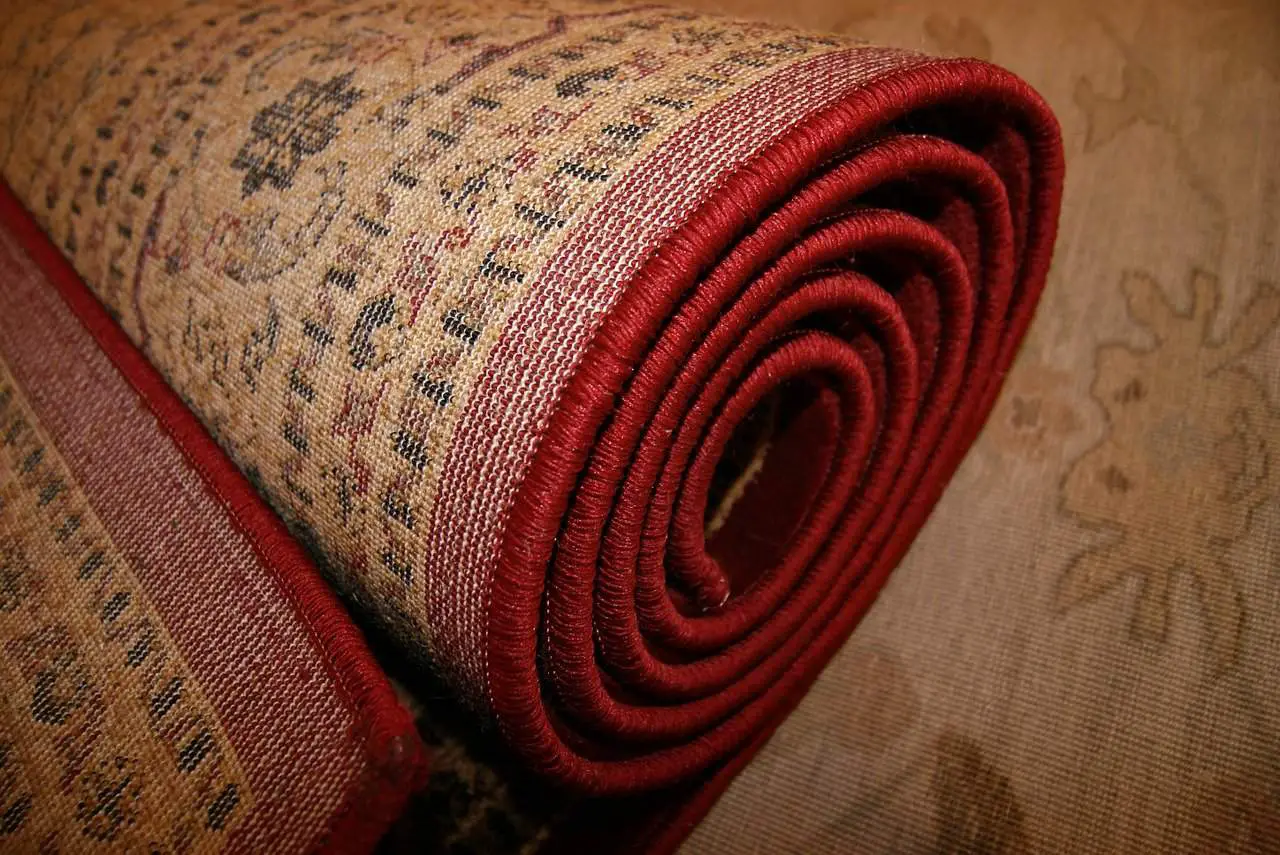
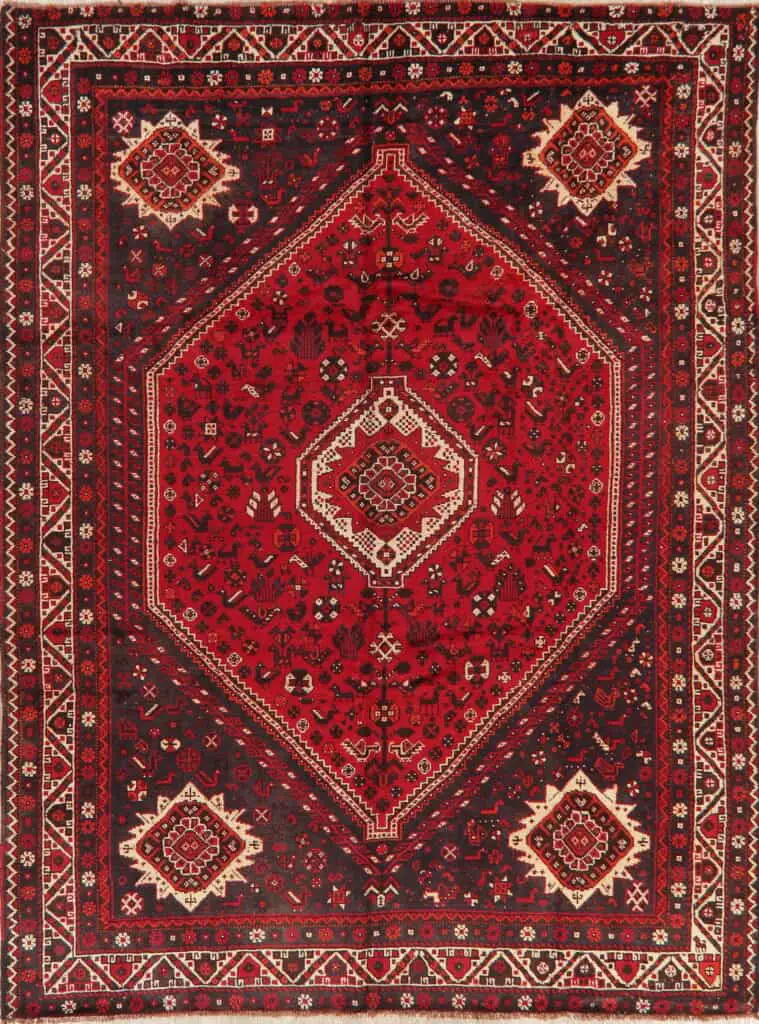
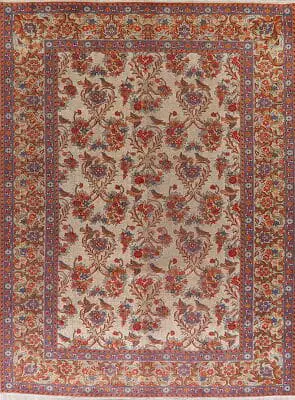
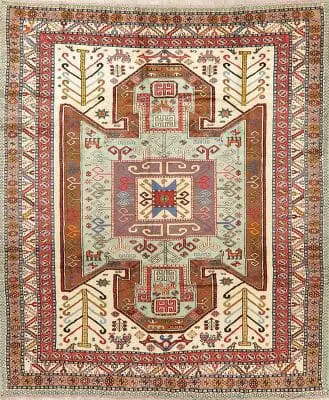



6 thoughts on “The Best Persian Rugs – Our Recommendations And Identification Tips”